AMD’s GTX 560 Ti Counter-Offensive: Radeon HD 6950 1GB & XFX’s Radeon HD 6870 Black Edition
by Ryan Smith on January 25, 2011 12:20 PM ESTPower, Temperature, & Noise
As was the case with gaming performance, we’ll keep our running commentary thin here. The Radeon HD 6950 1GB is virtually identical to the 2GB card, so other than a few watts power difference (which can easily be explained by being an engineering sample) the two are equals. It’s the XFX Radeon HD 6870 Black Edition that has caught our attention.
| Radeon HD 6800/6900 Series Load Voltage | |||||
| Ref 6870 | XFX 6870 | Ref 6950 2GB | Ref 6950 1GB | ||
| 1.172v | 1.172v | 1.1v | 1.1v | ||
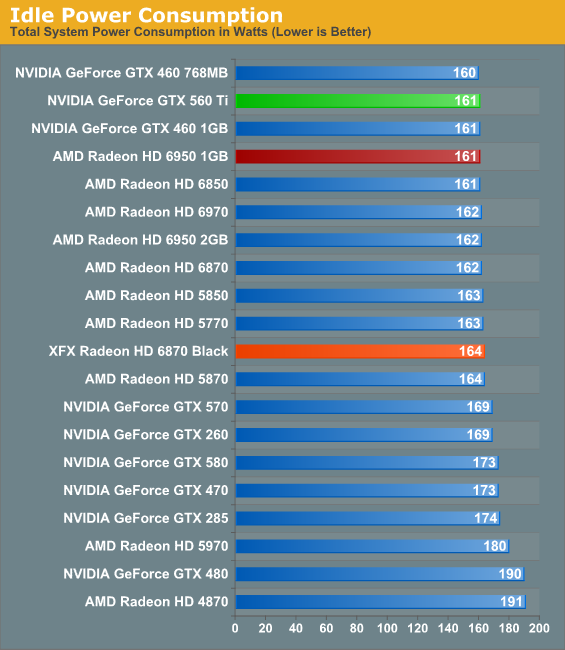

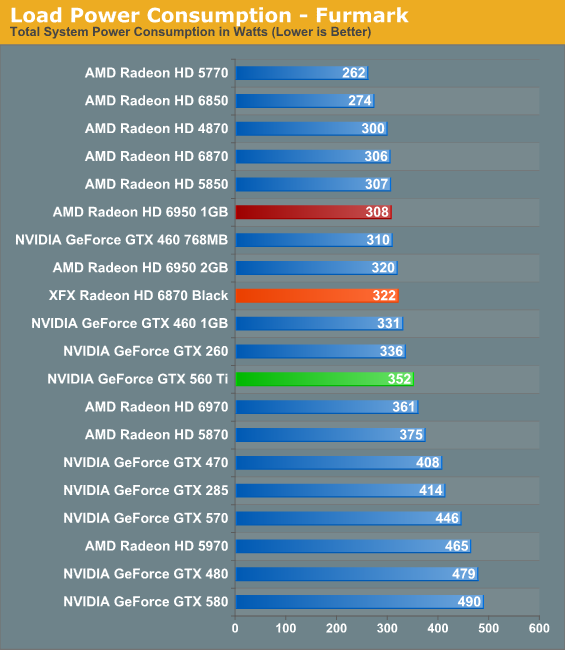
While the XFX 6870 has the same load voltage as the reference 6870, between the change in the cooler and the higher core and memory frequencies power usage still goes up. Under Crysis this is 11W, and under FurMark this expands to 16W. Unfortunately this factory overclock has wiped out much of the 6870’s low power edge versus the 6950, and as a result the two end up being very close. In practice power consumption under load is nearly identical to the GTX 460 1GB, albeit with much better gaming performance.
Meanwhile this is one of the few times we’ll see a difference between the 1GB and 2GB 6950. At idle and under Crysis the two are nearly identical, but under FurMark the 1GB reduces power consumption by some 12W even with PowerTune in effect. We believe that this is due to the higher operating voltage of the 2Gb GDDR5 modules AMD is using on the 2GB card.
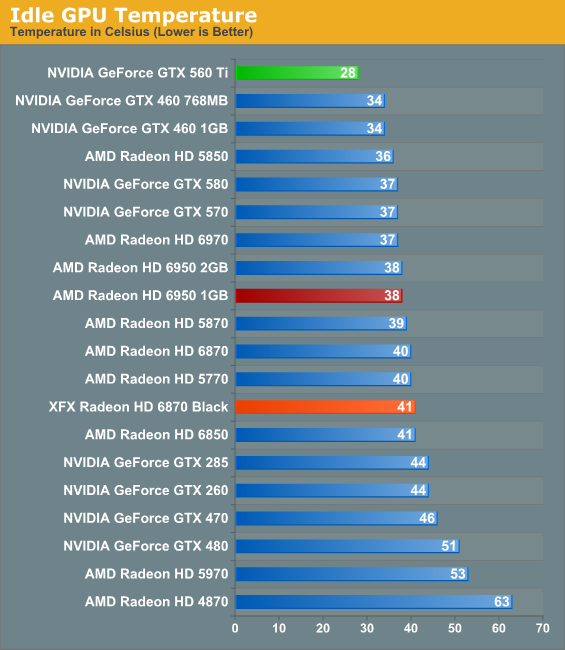


As far as temperatures go both cards are in the middle of the pack. The vapor chamber cooler on the 6900 series already gives it a notable leg up over most cards, including the XFX 6870. At 41C the XFX card is a bit warm at idle, meanwhile 78C under load is normal for most cards of this class. Meanwhile the 6950 1GB and 2GB both perform identically, even with the power consumption difference between the two.
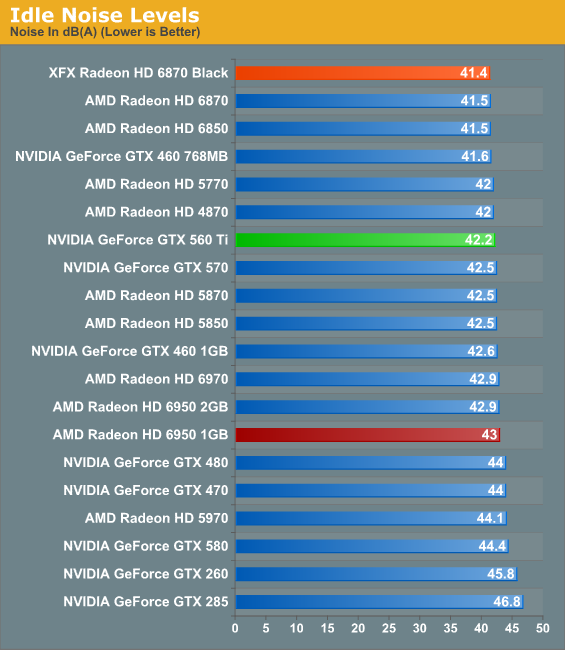
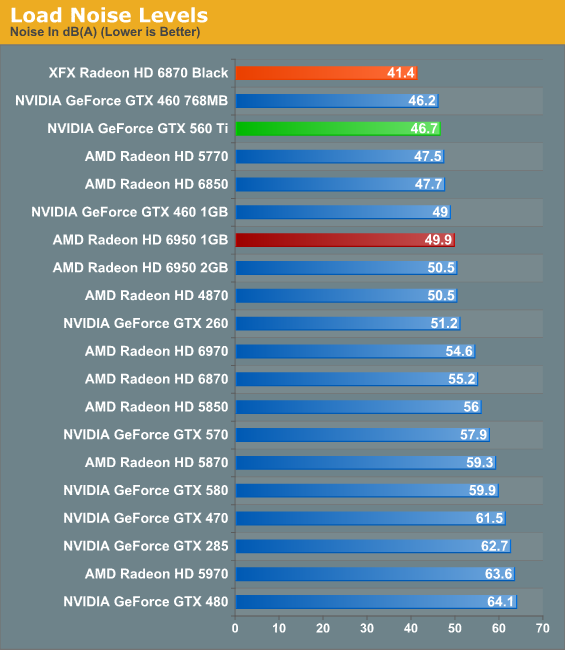
Last but certainly not least we have our noise testing, and this is the point where the XFX 6870 caught our eye. The reference 6870 was an unremarkable card when it came to noise – it didn’t use a particularly advanced cooling design, and coupled with the use of a blower it ended up being louder than a number of cards, including the vapor chamber equipped Radeon HD 6970. The XFX 6870 reverses this fortune and then some due to XFX’s well-designed open-air cooler. At idle it edges out our other cards by a mere 0.1dB, but the real story is at load. And no, that’s not a typo in the load noise chart, the XFX Radeon HD 6870 Black Edition really is that quiet.
In fact at 41.4dB under load, the XFX 6870 is for all intents and purposes a silent card in our GPU testbed. Under load the fans do rev up, but even when doing so the card stays below the noise floor of our testbed. Compared to the reference 6870 we’re looking at just shy of a 14dB difference between said reference card and the XFX 6870, a feat that is beyond remarkable. With the same warning as we attach to the GTX 460 and GTX 560 – you need adequate case cooling to make an open-air card work – the XFX Radeon HD 6870 Black Edition may very well be the fastest actively cooled quiet card on the market.
Meanwhile for the Radeon HD 6950 1GB and 2GB, we’re once again left with results that are nearly indistinguishable. Under load our 1GB card ended up being .6dB quieter, an imperceptible difference.










111 Comments
View All Comments
rdriskill - Tuesday, January 25, 2011 - link
Given that it is a lot easier to find a 1920 x 1080 monitor now than it is to find a 1920 x 1200 monitor, would that resolution make more sense to list in these kinds of comparisions? I realise it wouldn't make much of a difference, but it is kind of strange to not see what, at least in my area, is the most common native resolution.james.jwb - Tuesday, January 25, 2011 - link
wouldn't mind seeing 27" res include at the high end (2560x1440) as up there pushes the cards much harder and could make all the difference between playable and unplayable. I realize this is more work though :)Ryan Smith - Tuesday, January 25, 2011 - link
As 16:9 monitors have 90% of the resolution of 16:10 monitors, the performance is very similar. We may very well have to switch from 19x12 to 19x10 because 19x12 monitors are becoming so rare, but there's not a lot of benefit in running both resolutions.The same goes for 25x14 vs. 25x16. Though in that case, 25x16 monitors aren't going anywhere.
Makaveli - Tuesday, January 25, 2011 - link
Great review.As for the complaints GTFO, is it somehow affecting your manhood that there is an overclocked card in the review?
Some of you really need to get a life!
ctbaars - Tuesday, January 25, 2011 - link
Hey! Don't you talk to Becky that way ....silverblue - Tuesday, January 25, 2011 - link
It's overclocked, sure, but it's an official AMD product line. If AMD had named it the 6880, I don't think anyone would've questioned it really.Shadowmaster625 - Tuesday, January 25, 2011 - link
The 6870 has 56 texture units and the 6950 has 88 , or 57% more. Yet if you add up all the scores of each you find that the 6950 is only 8% faster on average. This implies a wasted 45% increase in SPs and/or texture units (which one?), as well as about 800 million wasted transistors. Clearly AMD needed to add more ROPs to the 6950. Also, since the memory clock is faster on the 6950, this implies even more wasted transistors. If both cards had the same exact memory bandwidth, they might very well only be 4% apart in performance! AMD's gpu clearly responds much more favorably to an increase in memory bandwidth than it does to increased texture units. It really looks like they're going off the wheels and into the weeds. What they need is to increase memory bandwidth to 216G/s, and increase their ROP-to-SIMD ratio to around 2:1.Yes I know about VLIW4... but where is the performance? Improvements should be seen by now. Like what Nvidia did with Civ 5. I'm not seeing anything like that from AMD and we should have been seeing that by now, in spades.
B3an - Wednesday, January 26, 2011 - link
....I like how you've completely missed out the fact that the 6870 is clocked 100MHz higher on the core, and the 6870 Black is 140MHz higher. You list all these other factors, and memory speeds, but dont even mention or realise that the 6870/Black have considerably higher core clocks than the 6950.Shadowmaster625 - Wednesday, January 26, 2011 - link
It is probably clocked higher because it has almost a billion fewer transistors. Which begs the question.... what the hell are all those extra transistors there for if they do not improve performance?DarkHeretic - Tuesday, January 25, 2011 - link
This is my first post, i've been reading Anand for at least a year, and this concerned me enough to actually create a user and post."For NVIDIA cards all tests were done with default driver settings unless otherwise noted. As for AMD cards, we are disabling their new AMD Optimized tessellation setting in favor of using application settings (note that this doesn’t actually have a performance impact at this time), everything else is default unless otherwise noted."
While i read your concerns about where to draw the line on driver optimisation Ryan, i disagree with your choice to disable select features from one set of drivers to the next. How many PC users play around with these settings apart from the enthusiasts among us striving for extra performance or quality?
Surely it would make be far fairer for testing to leave drivers at default settings when benchmarking hardware and / or new sets of drivers? Essentially driver profiles have been tweaking performance for a while now from both AMD and Nvidia, so where to draw the line on altering the testing methodology in "tweaking drivers" to suit?
I'll admit, regardless of whether disabling a feature makes a difference to the results or not, it actually made me stop reading the rest of the review as from my own stance the results have been skewed. No two sets of drivers from AMD or Nvidia will ever be equal (i hope), however deliberately disabling features meant for the benefit of the end users, just seems completely the wrong direction to take.
As you are concerned about where AMD is taking their driver features in this instance, equally i find myself concerned about where you are taking your testing methodology.
I hope you can understand my concerns on this and leave drivers as intended in the future to allow a more neutral review.
Regards